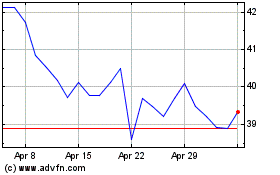Data usage on Verizon's 5G Ultra Wideband network has increased 249%
June 01 2022 - 8:00AM

As consumers experience the lightning fast speeds of Verizon’s 5G
Ultra Wideband service and as enterprise and small business
customers see the value in the scalability and flexibility of the
advanced technology, data usage on the new service continues to
climb. Since January of 2021, data usage on Verizon's 5G
Ultra Wideband network has increased 249%. To meet that
growing demand, in 2022, Verizon plans to deliver about 175 million
POPs by year end, and will deliver at least 250 million POPs by the
end of 2024.
5G Ultra Wideband customers are seeing ultra-fast wireless
speeds, up to 4 Gbps in some places, allowing them to download and
stream movies and TV shows in seconds, videoconference and
collaborate remotely in near real time, and take advantage of new
immersive customer experiences never before available wirelessly.
Enterprise customers are now enjoying greater access to the
technology that can dramatically accelerate their digital
transformation, revolutionizing how they interact with their
customers, track inventory, manage operations and engage with their
workforce.
“As the world continues to transition toward increased
connectivity, we are playing a critical part in building and
expanding this technologically advanced platform,” said Kyle Malady
EVP and President, Global Networks and Technology. “We are leading
the way in meeting the demand for fast, reliable connections for
both consumers and businesses, and the demand for this service is
only accelerating.”
Rapid 5G adoption is a result of the company’s
network-as-a-service foundation and is reflected in its core
vectors of growth and innovation across mobility, nationwide
broadband, mobile edge compute and business solutions, the value
market and network monetization.
Customers using Verizon’s 5G Ultra Wideband are already seeing
peak speeds in the gigabit range and are reaping the benefits of
the massive capacity of this network, especially in gathering
places like arenas and convention centers. The massive capacity of
5G Ultra Wideband leads to more opportunities across the board,
including accommodating massively large crowds at sporting and
entertainment events where data usage is typically in extremely
high demand. As Verizon gets access to additional spectrum, the
speeds and capacity on the 5G Ultra Wideband service will continue
to grow, and customers in more parts of the country will reap the
benefits.
Fastest growing states
Far over-indexing the average national growth of 279%, a few
states have led the way in driving the data growth average
up. Since January of 2021, usage in Maryland has grown by
1631%, Delaware by 1526%, Pennsylvania by 859%, New Jersey by 779%
and Virginia by 744%.
States that use the most 5G Ultra Wideband
data
While Maryland, Delaware, Pennsylvania, New Jersey and Virginia
are growing their usage quickly, they can’t catch the states that
are currently using the most 5G Ultra Wideband data (as of April
2022). In order, those states are: California, Indiana,
Illinois, Arizona, Texas, Michigan, Florida, Minnesota, Nevada, and
Ohio.
States quickest to switch from 4G to 5G
Residents and visitors in Nevada lead the pack in switching data
use from 4G to 5G with more than a quarter of their data being used
over 5G service. They are closely trailed by (in order) Indiana
(20%), Minnesota (20%), Arizona (17%), Illinois (15%) and Michigan
(14%).
These adoption and growth rates demonstrate the high demand for
5G Ultra Wideband service and with 5G phone penetration continuing
to grow, Verizon expects usage to climb sharply. 5G phone
penetration will be over 60% by 2023 and greater than 80% by 2025 -
The fastest adoption of new technology of any G so far.
To meet that growing demand, in 2022, Verizon plans to deliver
about 175 million POPs by year end, and will deliver at least 250
million POPs by the end of 2024.
Media contact: Karen
Schulz864.561.1527Karen.Schulz@verizon.com
Verizon Communications (NYSE:VZ)
Historical Stock Chart
From Mar 2024 to Apr 2024

Verizon Communications (NYSE:VZ)
Historical Stock Chart
From Apr 2023 to Apr 2024
